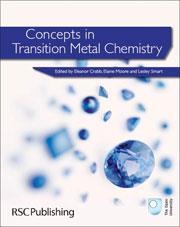Simon Cotton reviews this introduction to transition metal chemistry
Concepts in transition metal chemistry
Eleanor Crabb, Elaine Moore and Lesley Smart (eds)
Cambridge: RSC 2010 | Pp40 | £24.95 | ISBN978 1 84973 060 0
Reviewed by Simon Cotton

This book has been written both as a text for the Open University course S347Metals and life, and also to serve as a stand-alone volume. A second book Metals and life, which covers metals in medicine and in plant and animal physiology, complements it.
This book comprises six chapters: an introduction to the 3d block and features of transition-metal chemistry, making much use of the accompanying DVD; consideration of the stability of particular oxidation states, particularly +2 and +3, linked with reduction potentials; coordination theory, including isomerism (geometric, optical, linkage); stability of complexes, including stability constants and HSAB theory; the application of crystal field theory to complexes, covering electronic spectra (including the influence of the spectrochemical series); and magnetism, including the Jahn-Teller effect; and finally MO theory, which introduces p bonding (with ligands like CO, CN-, N2 and NO) as well as the 18-electron rule. Quite apart from the DVD, there is effective use of colour illustrations, showing - for example - the effect on colour of stepwise replacement of water in Ni( II ) complexes by 1,2-diaminoethane. The book is generally accurate, but I'd query the species [Fe(SCN)4]- on page 121.
This book affords a good introduction to the subject but, inevitably, even with the DVD, there is a limit to what can be accommodated in this space, and the interested student (or teacher) wanting to know more about the chemistry of individual elements or looking for more examples would be advised to supplement this with another text.






No comments yet